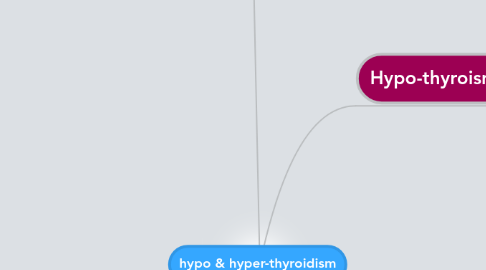
1. Hyper-throidism
1.1. Hyper-metabolic sate cause by elevated circulating level of free T3 & T4
1.2. caused most commonly by hyperfunction of thyroid gland
1.3. Cuases of thyrotoxicosis
1.3.1. associated with hyperthyroidism
1.3.1.1. primary
1.3.1.1.1. Graves disease
1.3.1.1.2. hyperfunctional multinodular goiter
1.3.1.1.3. hyperfunctional adenoma of the thyroid gland
1.3.1.2. secondary
1.3.1.2.1. TSH-secreting pituitary adenoma (rare)
1.3.2. not associated with hyperthyroidism
1.3.2.1. subacute Granulomatous thyroiditis (painful)
1.3.2.1.1. viral infection (usually follow URTI)
1.3.2.2. subacute lymphocytic thyroiditis (painless)
1.3.2.3. Factitious (artifical) thyrotoxicosis
1.3.2.3.1. exogenous thyroxine intake
1.3.2.4. struma ovarii
1.3.2.4.1. ovarian teratoma with thyroid tissue
1.4. in clinical practice thyrotoxicosis & hyperthyroidism are used interchangeably!
2. Hypo-thyroism
2.1. Hashimoto thyroiditis (Chronic lymphocytic thyroiditis)
2.1.1. pathogenesis
2.1.1.1. Gradual thyroid failure by autoimmune destruction of thyroid gland
2.1.1.2. strong genetuc componet
2.1.2. definition
2.1.2.1. autoimmune disease in which immune system react against a variety of thyroid antigens (thyroglobulin & thyroid peroxidase)
2.1.2.2. main feature is progressive depletion of thyroid epitheial cell (thyrocytes) replaced by mononuclear cell infiltration and fibrosis
2.1.2.2.1. infiltration by T-Cells , macrophages & plasma cells.
2.1.3. morphology
2.1.3.1. microscopcially
2.1.3.1.1. extensive infiltration of parenchyma by mononuclear inflammatory infilitrate containg small lymphocytes,plasma cell & well developed germinal centers
2.1.3.1.2. thyroid follicle are atrophic & lined in many areas by epithelial cell distinguished by presence of eosinophlis, granular cytoplasm termed Hurthele cells
2.1.3.2. grossly
2.1.3.2.1. cut surface is pale , yellow , tan , firm & somewhat nodular !!
2.1.3.2.2. diffuse enlargment if thyroid gland
2.1.4. features
2.1.4.1. most common cause of hypothyroidism in areas where iodine level are sufficient.
2.1.4.2. female prodiminabce of 10: 1 to 20:1
2.1.4.3. age 45-65
2.2. clinical manifestation of hypothyroidism
2.2.1. Cretinism
2.2.1.1. in pediatric age group
2.2.1.2. severe mental retardation
2.2.1.3. short stature
2.2.1.4. coarse facial features
2.2.1.5. protrudung tongue
2.2.1.6. umbilical hernia
2.2.2. Myxedemia
2.2.2.1. in adult age group
2.2.2.2. slowing of physical and mental activity
2.2.2.3. mental sluggishness
2.2.2.4. overweight
2.2.2.5. GAGs and hyaluronic acids in skin, subcutaneous tissue & visceral sites
2.2.2.6. non-pitting edema
2.2.2.7. broading and coarsening of facial features
2.2.2.8. enlargment of the tongue
2.2.2.9. deeepening of the voice
2.3. features
2.3.1. primary or secondary
2.3.1.1. secondary (central) hypothyroidism is caused by deficiency of TSH & far more UNcommon TRH deficiency!
2.3.1.2. Autoimmune hypothyroidism (Hoshimotos): is the most common cause of hypothyroidism in iodine-sufficient areas of the world
2.3.1.2.1. primary hypothyroidism !!
2.3.2. Acquired or congenital
2.3.2.1. acquired
2.3.2.1.1. acquired hypothyroidism can be caused by surgical or radation-induced ablation of thyroid parenchyma
2.3.2.2. congenital
2.3.2.2.1. congenital hypothyroidism is most often the result of endemic iodine deficency in diet
2.3.2.2.2. less common forms of congenital hypothyroidism include inborn errors of thyroid metabolism ( dys-hormono-genetic goiter )
2.3.3. definition
2.3.3.1. it's caused by strctural or functional dearrangment that interferes with the production of adequate level of thyroid hormone.
2.3.4. Epidemology
2.3.4.1. 10 fold more common in women than in men
2.3.4.2. increase incidance with age
2.4. Laboratory findings:
2.4.1. has a vital role in the diagnosis of suspected hypothyroidism because of NON-specific nature of the symptoms.
2.4.2. serum TSH
2.4.2.1. The most sensetive screning test fir this disorder
2.4.2.2. TSH is increased in primary hypothyroidism.
2.4.2.3. TSH is NOT increased in secondary hypothyroidism.
2.4.3. Serum T4
2.4.3.1. serum T4 is decreased in hypothyroisim of any origin

